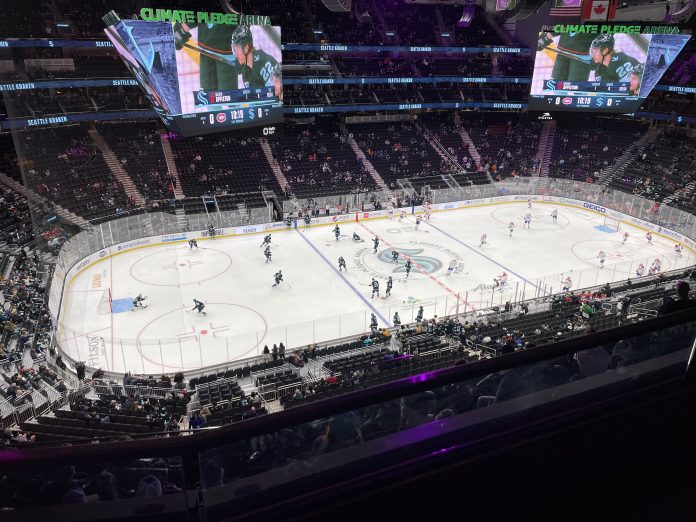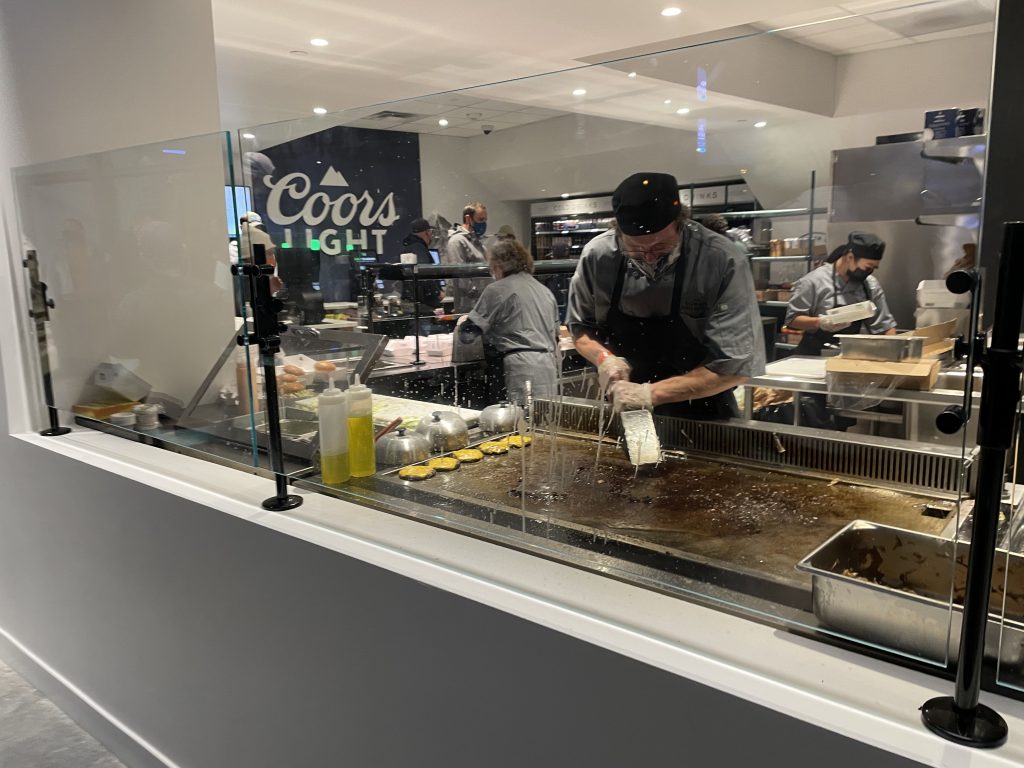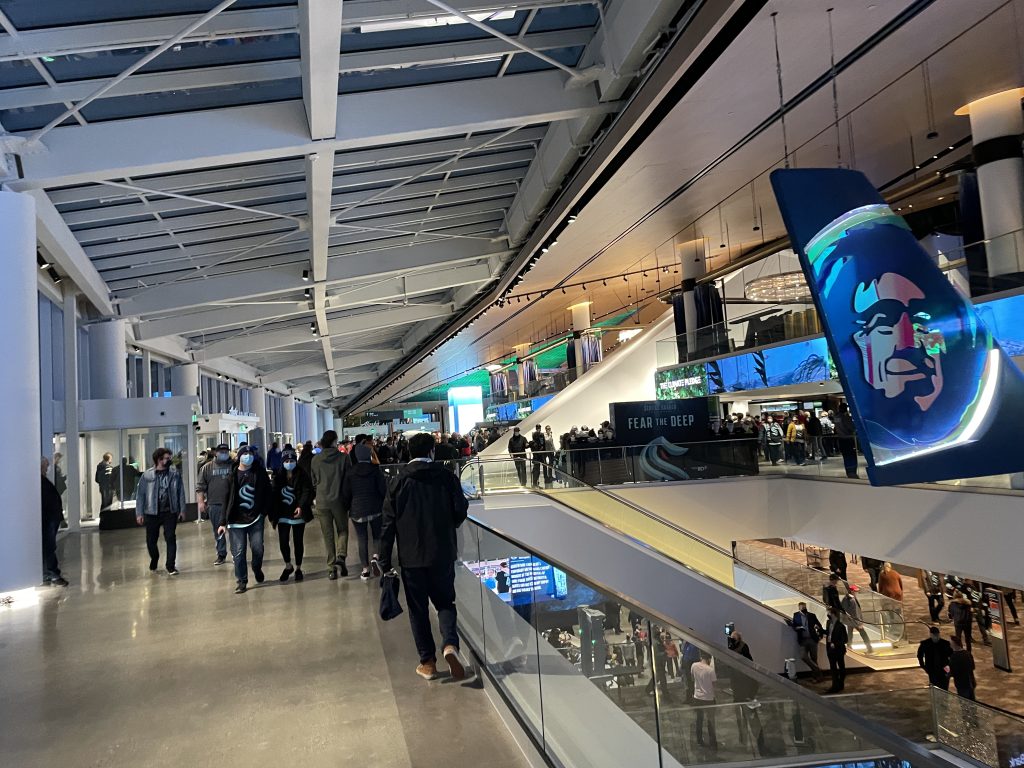
(And four things we don’t)
Now that the dust has subsided on construction and the glitter has settled on the opening night festivities, let’s get down to the brass tacks. Seattle has a brand new arena for a brand new hockey team, the Kraken. Here’s a close look at what works, and what doesn’t, from the most important vantage point: my seats at the second home game of the season.
As you can see from the feature photo, these are not the most expensive seats in the place, but I’m personally a fan of the front rows of the upper deck. You get to see all the action, yell your head off, and have a few bucks left over for beers. We already like our neighboring ticket holders, and were happy to find they were on the same ticket plan. The folks that fill these seats are the ones who, over the course of twenty odd years, will decide how beloved (or loathed) the Climate Pledge Area becomes. So here’s our take on what worked, and what didn’t.
It took some effort to get to this point. On Tuesday, the Kraken raised a banner for the 1917 Seattle Metropolitans, the first US team to win hockey’s championship Stanley Cup by defeating the Montréal Canadiens. While the Canadiens spent the rest of the 20th Century dominating the sport, the Metropolitans folded in 1924. Their Seattle Ice Arena was demolished in 1963 and is now the site of the Olympic Hotel on University Street. Seattle has been caught between minor league hockey and the Vancouver Canucks since.
The arena saga is filled with more recent heartbreak. Opened as the Washington State Pavilion for the 1962 World’s Fair, the facility held “a ‘floating city’ showing how man will live, work and play in the coming century.” Naturally, it featured exhibits by Pan Am and General Motors. After the fair, the arena and its iconic roof were converted to sports and entertainment complex. These hosted the NBA SuperSonics from inception in 1967 through a championship in 1979. The arena was renovated to the studs in 1995, and reopened as Key Arena, but that was not enough. Team owner and coffee impresario Howard Schultz flipped the team to Clay Bennett who vanished the Sonics out of town in 2008.
Even during the Sonics’ time, there were pushes to move the arena out to the suburbs. After the team relocation, the chorus became louder, cresting in Chris Hansen’s proposal to open a new arena in SoDo to attract a new basketball franchise. That proposal met hard objections from the Mariners and the Port of Seattle. A required street vacation failed at the city council, dooming the project and resulting in angry misogyny and death threats pointed at female councilmembers.
But that reopened the door to a massive rehabilitation of the Seattle Center facility. Two proposals for renovation yielded a winning bid for a hockey-first facility from Oak View Group (OVG). OVG’s proposal levitated the historic roof while building a completely new facility underneath, adding a new atrium on the south end to create a full oval seating bowl. Me and 31,999 other folks threw down seat deposits on March 1, 2018. The NHL awarded the 32nd franchise ten months later. After the check for a cool $650 million expansion fee cleared the bank, the Seattle Kraken started play with five straight away games before opening the new venue on Saturday with a loss to Vancouver.
And now, we play hockey for real.
Love #1: The approach
We exited Adams Elementary in Ballard at 5:00pm, walked across the neighborhood, and got on the southbound Rapid Ride D. A seated, socially distanced ride later, and we were drinking a Vita coffee in KEXP at 5:45pm. Transit to the new facility is a breeze, particularly from my house which is the most important measure of effectiveness. No parking fees. No falls from electric scooters. 10/10, will bus again.
No Love #1: The entry
Entering with a mixed vaccination group was a pain in the butt. Two vaccinated adults, one vaccinated teen, and an unvaccinated 10 year old. The hang up wasn’t the youngest, as she was just waived through. The teen didn’t clear the bar to be, well Clear. That’s the app used by Climate Pledge Arena to validate vaccines. It has a minimum age of 14, so the youngest group that is eligible for vaccines isn’t eligible for the speed pass. There is a single tent set up outside the southeast corner of the arena (the former site of the skate park, natch) handling everyone that cannot access the app or is in the 12 to 13 age group. The line moved reasonably fast, but was still a cluster at the end before the appropriate cards were checked and hand stamps were distributed. Entering the arena, the teen’s stamps were not checked.
Love #2: The building
Holy crap, the place is beautiful. We entered the southeast side of the facility, which features the new glass atrium. Street/plaza level is the upper concourse. You go downward through escalators to get to the lower seating bowl and the ice. Continuing around the main level offers split stairs to 100 and 200 level seats.
The building is shiny and modern and clean. Many ultra-high efficiency buildings have a concrete coldness to them, with glass and chrome. The designers blunted this with projected aquariums and wood highlights in the right spots. The historic windows (always questionable to me, given better efficiency ones available) are a dark grid in the light colored context, an interesting contrast. I actually squealed a bit at the giant slanted roof support hanging out in the south end atrium. It was “hello friend, I know you” in a terrarium. Climate Pledge Arena feels like a second-gen iPod, a completely personal piece of technology that’s zeroing in on peak design and on the verge of finding the right apps to fit.
Our particular seats are in the northwest corner of the building, so we covered half of the facility. We’re on the upper balcony at the point where the curve starts from sideline to end zone. That taper put some knees into a squeeze, but the seats themselves are on the comfortable modern end of the width measure. These aren’t bleachers. This is a comfortable venue to watch the modern hockey game.
No Love #2: The upper concourse food
Now, upper concourses of stadiums have notoriously questionable food choices. It’s the cheap seats, so it won’t be foie gras. There’s a reason we know the quickest way down from the upper deck of Lumen Field to get the good meat pies instead of suffering through cold garlic fries. The downstairs levels of the new arena have lots of options that don’t stretch upwards.
This isn’t outright terrible, but can fail in execution if chicken tenders and fries aren’t hot and ready to go as unfortunately was the case for us. Stockpiled cheeseburgers without cheese and a complete lack of popcorn are unacceptable. The shakedown of the new arena has to open up some better food options on the real fans’ level. And they must be prepared for the crushes before the game and between periods. We didn’t see staff getting the kind of support that suggest these rushes were planned for.

A lot of press has been spent on the arena’s grab-and-go food, and there is some novelty to it. Sponsorship by The Mothership does stuff like that. However, the food mix needs to improve. Draft beers had minimum food options and ot food and candy only came with canned beer and water. No one had ice cream late in the game. For a city that has sushi and Ivar’s Dogs in the ballpark, something better than boxed fries and canned Elysian is in order at the hockey game.
One caveat: it was awesome to have stand alone fountain sodas with water option. I was okay paying $9 for a reusable cup when it got refilled four times with ice and water and I didn’t have to stand in a concession line to do it. I would love it if the fountain dispensers had a plain soda water option, but as is, they are fantastic.
Love #3: The staff
Just before the third period, the short people in our party demanded one last round of food. They saw soft pretzels, so we were having soft pretzels. The concession closest to our seats served them and draft beer, so fine.
There was no line for the draft counter, even with the neighboring grab-and-go area hopping. When asked for a Modelo and two pretzels, the staff member told me that the pretzels were colder than the beer. They were chugging along in the rotating pretzel warmer, but it would be a great while before edible. Yes, a disappointment, but an appreciated one.
Over and over, the staff were unbelievably friendly, conscientious of their place in this massive machine, and accommodating to the point they could be. No one was handing out free beer, but the staffers at every station were as helpful a human being as one could ask for. Thousands of people are not kind. But the staffers, to a person, responded with exactly the right amount of firmness and humor. They were on point at the self-checkouts authorizing beers and giving advice to “keep that bar code clear or it’ll scan you a hundred hot dogs.” Everyone one of them deserves more than they are getting paid, and better support than they had on the ground.
No Love #4: THAT Key Arena bathroom design flaw
There is literally nothing left of Key Arena inside this building. They gutted the entire place to build the new facility. But the men’s rooms along the east and west sides are still cul-de-sacs with a long line of incoming dancers in a tight squeeze, waiting for the current relievers to walk out. No loops with two doorways. Carry through all the banners and history, but it’s questionable why this particular one-gateway bathroom design was continued from the old barn.
Love #4: Brandon Tanev, and the entire goddamn Kraken enterprise
With a little over half the game to go, I had to decide if I was going to fling a $30 Kraken hat on to the ice from the third story of the arena.
Brandon Tanev, the Kraken’s leading scorer, had just shot his second goal of the evening past the Habs’ goalie Jake Allen, now at our end of the ice. The score was Kraken 4, Canadiens 1 and the short people in our party were bleary with cheering and snacks. I was preparing for a hat trick.
It’s been three years (eight pandemic years) since I plopped down a non-insubstantial amount of money to secure this seat on this day. Now a permanent relocatee in this weird, damp, pine scented utopia, I get to be present for the start of a new sports franchise. Me and 17,000 other goobers get to sit here on a Tuesday night and see a dozen millionaires play ice hockey in a city where ice paralyzes existence.
And everything suggests that the organization understands how weird this is and is bending over backwards to be a part of the city they’ve settled. They know the competition, not just the Sharks and Canucks, but the strong Nordic/tech worker predilection to be at home in thick socks by 8:00pm. They found overachieving lunatics like Brandon Tanev and plucked him from the Pittsburgh Penguins to skate like a madman and score enough points to get us Tuesday night goobers to be lunatics with him.
For the record, the hat was going to go. It ended up not getting flung on the ice, but I was ready.
No Love #4: The exit
1st Ave bus routes. That is all. It shouldn’t be all, but it is.
Love #5: Weekday winter sports
And now this is what we do in the winter. It’s not the perennial Sounders marches to the playoff matches in breezy rain. It’s not the weekend pilgrimages to Montlake or SoDo for a full day of reckless debauchery and tectonic noise. This is a Tuesday in October. As it will be Mondays in December and Thursdays in January. We had an entire day of school, errands, packed lunches, and music lessons all before changing into hockey sweaters and heading down to see the game. Yes, exciting. Yes, also part of life, not a departure.
Seattle has weekday winter sports again, and we have to remember what that means. In the short term, it’s going to mean straightening out transit around the arena. That’s not some extreme flood level transit planning. It’s getting Queen Anne Avenue bike lanes and buses to work correctly, like they should already.
Longer term, Lower Queen Anne isn’t going to look the same. Seattle has a jewel of a facility that should spur restaurants and bars to operate before and after events. Sleepy Irish pubs and sports dives are going to shake off some cobwebs. The long walk across Seattle Center to, well, not much, is going to need a facelift. But with the number of houses that are being built around Seattle Center, this should already be the case. And that will be part of regular, daily life. Not a departure.
Of course, there’s a lot more coming than just hockey. The Seattle Storm and Seattle U will move back into the area this year. Then there’s a flood of concerts coming over the next two years. The city will be on the short list for NCAA tournaments in all sorts of sports, and the arena’s going to get matched with the expanded convention center for massive events. That’s all before we talk NBA team. No sleepy corner of Uptown any more, every side of this arena needs to be ready for activity going well into the night. Not because it’s something extraordinary, but because this is what we do now.
But that’s next week. Tonight, we’ll revel in the city and the team’s victory. It’s a good spot to be in now and it’ll be a better spot to be in soon.
Ray Dubicki is a stay-at-home dad and parent-on-call for taking care of general school and neighborhood tasks around Ballard. This lets him see how urbanism works (or doesn’t) during the hours most people are locked in their office. He is an attorney and urbanist by training, with soup-to-nuts planning experience from code enforcement to university development to writing zoning ordinances. He enjoys using PowerPoint, but only because it’s no longer a weekly obligation.



